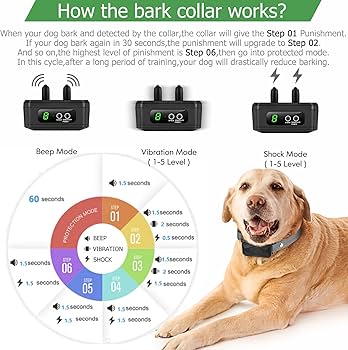
Bark collars are training devices that deliver a mild electric shock to a dog’s neck when it barks. They are often used to curb excessive barking, a common problem that can be frustrating for both dog owners and their neighbors. While bark collars can be effective in reducing barking, they should only be used as a last resort after other training methods have failed.
There are a number of reasons why bark collars should only be used as a last resort. First, they can be harmful to dogs. The electric shock can cause pain and anxiety, and it can even lead to more serious problems such as aggression. Second, bark collars can be ineffective in the long term. Dogs often learn to avoid the shock by barking less frequently, but they do not learn to stop barking altogether. This means that the problem will likely return once the collar is removed.
If you are considering using a bark collar, it is important to talk to your veterinarian first. They can help you determine if a bark collar is right for your dog and can provide you with instructions on how to use it safely and effectively.
1. Effectiveness
The effectiveness of bark collars in reducing barking is a complex issue. There is some evidence that bark collars can be effective in reducing barking, but there is also evidence that they are not always reliable. One study found that bark collars were effective in reducing barking in 80% of dogs, but another study found that they were only effective in reducing barking in 50% of dogs.
There are a number of factors that can affect the effectiveness of bark collars, including the type of collar, the dog’s temperament, and the environment in which the collar is used. Some dogs are more sensitive to the shock than others, and some dogs may be more likely to bark in certain situations, such as when they are left alone or when they are around other dogs.
It is important to note that bark collars are not a magic bullet. They will not work for all dogs, and they should not be used as a substitute for training. If you are considering using a bark collar, it is important to talk to your veterinarian or a certified dog trainer first to determine if it is right for your dog.
2. Humaneness
Bark collars work by delivering a mild electric shock to a dog’s neck when it barks. While this shock may be effective in reducing barking, it can also be harmful to dogs. The shock can cause pain and anxiety, and it can even lead to more serious problems such as aggression.
There are a number of reasons why bark collars are not humane. First, the shock can be painful. Dogs have very sensitive skin, and the shock from a bark collar can be very painful. Second, the shock can be anxiety-provoking. Dogs do not understand why they are being shocked, and this can lead to anxiety and fear. Third, the shock can lead to aggression. Dogs who are shocked may become aggressive towards people or other animals in order to protect themselves.
For these reasons, bark collars should only be used as a last resort after other training methods have failed. If you are considering using a bark collar, it is important to talk to your veterinarian or a certified dog trainer first to determine if it is right for your dog.
3. Training
Bark collars are a controversial training tool. Some people believe that they are an effective way to stop dogs from barking, while others believe that they are cruel and inhumane. One of the main criticisms of bark collars is that they do not teach dogs why barking is wrong. They simply punish them for barking, which can lead to fear and anxiety.
In order for a dog to learn why barking is wrong, they need to understand the consequences of their actions. Bark collars do not provide this information. They simply deliver a shock to the dog’s neck, which can be very painful and frightening. This can lead to the dog becoming afraid of barking, but it does not teach them why barking is wrong.
A better way to train a dog to stop barking is to use positive reinforcement. This means rewarding the dog for good behavior, such as being quiet. When the dog barks, you can simply ignore them. If they continue to bark, you can give them a command, such as “quiet.” If they obey the command, you can reward them with a treat or praise.
This method of training is much more effective than using a bark collar. It teaches the dog why barking is wrong and it does not cause them any pain or fear.
Conclusion
Bark collars are not an effective way to train a dog to stop barking. They simply punish the dog for barking, which can lead to fear and anxiety. A better way to train a dog to stop barking is to use positive reinforcement. This method is more effective and it does not cause the dog any pain or fear.
4. Long-term effects
One of the main problems with bark collars is that they can be ineffective in the long term. Dogs are intelligent animals, and they can quickly learn to avoid the shock by barking less frequently. However, this does not mean that they have learned to stop barking altogether. They have simply learned to bark less often in order to avoid the shock.
This can be a problem for several reasons. First, it means that the dog is still barking, even if they are barking less frequently. This can still be a nuisance for dog owners and their neighbors. Second, it means that the dog has not learned why barking is wrong. They have simply learned to avoid the shock, which is not the same thing as learning why barking is wrong.
In order for a dog to learn why barking is wrong, they need to understand the consequences of their actions. Bark collars do not provide this information. They simply deliver a shock to the dog’s neck, which can be very painful and frightening. This can lead to the dog becoming afraid of barking, but it does not teach them why barking is wrong.For these reasons, bark collars are not an effective long-term solution for stopping a dog from barking. They may reduce the frequency of barking, but they do not teach the dog why barking is wrong. A better way to train a dog to stop barking is to use positive reinforcement. This method is more effective and it does not cause the dog any pain or fear.
5. Alternatives
The use of bark collars as a method of training has been a controversial topic among dog owners and trainers alike. While bark collars may provide a temporary solution to excessive barking, they often fail to address the underlying causes of the behavior and can even exacerbate the problem in the long run. In contrast, alternative training methods that focus on positive reinforcement and behavior modification offer a more humane and effective approach to reducing barking behavior.
-
Positive Reinforcement
Positive reinforcement involves rewarding a dog for desired behaviors, such as remaining quiet. By providing treats, praise, or other rewards when the dog is quiet, owners can encourage the behavior and make it more likely to occur in the future. This approach helps to build a positive association between remaining quiet and receiving something the dog enjoys, promoting long-term behavior change.
-
Behavior Modification
Behavior modification techniques aim to identify the triggers that cause a dog to bark and then develop strategies to change the dog’s response to those triggers. This may involve desensitization, where the dog is gradually exposed to the trigger in a controlled environment while remaining calm, or counter-conditioning, where the dog is taught to associate the trigger with a positive outcome, such as receiving a treat. By changing the dog’s emotional response to the trigger, behavior modification can effectively reduce barking behavior.
Compared to bark collars, positive reinforcement and behavior modification methods are more humane as they do not rely on punishment or negative reinforcement. These techniques focus on building a strong bond between the dog and the owner and promoting desired behaviors through positive experiences. Moreover, these methods address the underlying causes of barking behavior, such as anxiety, boredom, or attention-seeking, providing a long-term solution to the problem.
6. Professional advice
Consulting with a veterinarian or certified dog trainer before using a bark collar is crucial for several reasons. First, professional advice can help determine if a bark collar is an appropriate solution for your dog’s specific needs and temperament. Different dogs respond differently to bark collars, and professional guidance can help assess whether a bark collar is likely to be effective and safe for your pet.
Secondly, professional advice can provide valuable insights into the proper use of bark collars. Bark collars come with various settings and features, and understanding how to adjust and use these settings correctly is essential for ensuring the collar’s effectiveness and safety. A veterinarian or certified dog trainer can demonstrate the proper way to fit the collar, adjust the settings, and monitor your dog’s response to ensure the collar is used humanely and effectively.
Moreover, professional advice can help identify underlying causes of excessive barking. Barking is often a symptom of an underlying issue, such as anxiety, boredom, or a medical condition. By consulting with a veterinarian or certified dog trainer, you can explore potential causes and develop a comprehensive plan to address the root of the problem, rather than simply relying on a bark collar as a temporary solution.
In summary, seeking professional advice before using a bark collar is essential for determining its suitability for your dog, ensuring its safe and effective use, and addressing the underlying causes of excessive barking. Professional guidance can help you make an informed decision about whether a bark collar is the right choice for your dog and provide the necessary knowledge and support to use it responsibly and effectively.
FAQs about Bark Collars
Bark collars are a controversial training tool, and there are many questions and concerns surrounding their use. Here are some frequently asked questions about bark collars, answered in a serious and informative tone:
Question 1: Are bark collars effective in reducing barking?
Answer: The effectiveness of bark collars varies depending on the individual dog and the situation. Some dogs may respond well to bark collars and reduce their barking, while others may not. It is important to note that bark collars are not a magic bullet and should not be used as a substitute for proper training.
Question 2: Are bark collars humane?
Answer: Bark collars can be harmful to dogs if not used properly. The electric shock from a bark collar can be painful and frightening for dogs, and it can lead to anxiety, fear, and even aggression. It is important to use bark collars only as a last resort and to follow the manufacturer’s instructions carefully.
Question 3: Do bark collars teach dogs why barking is wrong?
Answer: No, bark collars do not teach dogs why barking is wrong. They simply punish dogs for barking, which can lead to fear and anxiety. A better way to train a dog to stop barking is to use positive reinforcement, such as rewarding the dog for being quiet.
Question 4: Are bark collars effective in the long term?
Answer: Bark collars may be effective in reducing barking in the short term, but they are not usually effective in the long term. Dogs can learn to avoid the shock by barking less frequently, but they do not learn why barking is wrong. This means that the problem will likely return once the collar is removed.
Question 5: Are there any alternatives to bark collars?
Answer: Yes, there are a number of more humane and effective alternatives to bark collars, such as positive reinforcement training, behavior modification, and anti-anxiety medication. It is important to consult with a veterinarian or certified dog trainer to determine the best course of action for your individual dog.
Question 6: When should I consider using a bark collar?
Answer: Bark collars should only be used as a last resort after other training methods have failed. It is important to consult with a veterinarian or certified dog trainer before using a bark collar to determine if it is right for your dog and to learn how to use it safely and effectively.
Summary: Bark collars can be an effective short-term solution for reducing barking, but they are not a magic bullet. They should only be used as a last resort after other training methods have failed. It is important to use bark collars only as a last resort and to follow the manufacturer’s instructions carefully.
Transition to the next article section:
Tips for Using Bark Collars
If you are considering using a bark collar, it is important to use it safely and effectively. Here are some tips:
Tip 1: Choose the right bark collar. There are many different types of bark collars on the market, so it is important to choose one that is right for your dog. Consider your dog’s size, temperament, and the severity of the barking problem.
Tip 2: Start slowly. When you first start using a bark collar, it is important to start slowly. Start by setting the collar to the lowest setting and gradually increase the intensity as needed.
Tip 3: Be consistent. It is important to be consistent with the use of a bark collar. The dog needs to learn that barking will always result in a correction.
Tip 4: Monitor your dog. It is important to monitor your dog closely when they are wearing a bark collar. This will help you to ensure that the collar is not causing any discomfort or distress.
Tip 5: Reward your dog. When your dog is quiet, be sure to reward them. This will help them to associate being quiet with positive reinforcement.
Summary: Bark collars can be an effective tool for reducing barking, but it is important to use them safely and effectively. By following these tips, you can help to ensure that your dog has a positive experience with a bark collar.
Transition to the article’s conclusion:
Conclusion
The effectiveness of bark collars in reducing barking is a complex issue. There is some evidence that bark collars can be effective, but there is also evidence that they are not always reliable. Bark collars can be harmful to dogs, causing pain, anxiety, and even more serious problems such as aggression. Bark collars do not teach dogs why barking is wrong; they simply punish them for barking. Bark collars can be ineffective in the long term, as dogs often learn to avoid the shock by barking less frequently, but they do not learn to stop barking altogether. There are a number of more humane and effective alternatives to bark collars, such as positive reinforcement and behavior modification.
Ultimately, the decision of whether or not to use a bark collar is a personal one. However, it is important to be aware of the potential risks and benefits before making a decision. If you are considering using a bark collar, it is important to talk to your veterinarian or a certified dog trainer first to determine if it is right for your dog.



